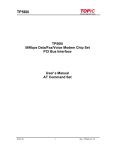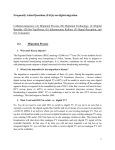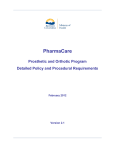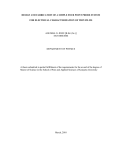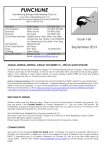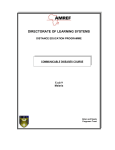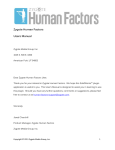Download Orthoses — Upper limb Orthoses — Specification
Transcript
DKS 2465: 2013 Orthoses — Upper limb Orthoses — Specification ii © KEBS 2013 — All rights reserved KS 2465: 2013 TECHNICAL COMMITTEE REPRESENTATION The following organizations were represented on the Technical Committee: Association for the Physically Disabled of Kenya Kenyatta University Ministry of Medical Services (MOMS) – Orthopaedic Technology Ministry of Medical Services (MOMS) – Occupational Therapy National Council of Persons with Disabilities (NCPWD) Kenya Medical Training College (KMTC) Kenya Society of Physiotherapist Kenyatta National Hospital National Association for Orthopaedic Technologist in Kenya (NAOT(K)) Isole Engineering Works Ministry of Nairobi Metropolitan Development Kenya Bureau of Standards – Secretariat REVISION OF KENYA STANDARDS In order to keep abreast of progress in industry, Kenya Standards shall be regularly reviewed. Suggestions for improvements to published standards, addressed to the Managing Director, Kenya Bureau of Standards, are welcome. © Kenya Bureau of Standards, 2009 Copyright. Users are reminded that by virtue of Section 25 of the Copyright Act, Cap. 12 of 2001 of the Laws of Kenya, copyright subsists in all Kenya Standards and except as provided under Section 26 of this Act, no Kenya Standard produced by Kenya Bureau of Standards may be reproduced, stored in a retrieval system in any form or transmitted by any means without prior permission in writing from the Managing Director. ii © KEBS 2013 — All rights reserved DRAFT KENYA STANDARD KS 2465: 2013 ICS …………….. Orthoses — Upper limb Orthoses — Specification KENYA BUREAU OF STANDARDS (KEBS) Head Office: P.O. Box 54974, Nairobi-00200, Tel.: (+254 020) 605490, 602350, Fax: (+254 020) 604031 E-Mail: [email protected], Web:http://www.kebs.org Coast Region P.O. Box 99376, Mombasa-80100 Tel.: (+254 041) 229563, 230939/40 Fax: (+254 041) 229448 Lake Region P.O. Box 2949, Kisumu-40100 Tel.: (+254 057) 23549, 22396 Fax: (+254 057) 21814 1. North Rift Region P.O. Box 2138, Nakuru-20100 Tel.: (+254 051) 210553, 210555 iii FOREWORD This Kenya Standard has been prepared by the KEBS/TC 132 Assistive Products for persons with Disabilities Technical Committee and it is in accordance with the procedures of the Bureau. The Standard was found necessary in ensuring the quality of orthoses either manufactured locally or imported into this country. This is only a guide to the manufacturers, fabricators, service providers and users of orthoses. Orthoses are orthopaedic devices designed and basically used to support, correct, accommodate, prevent further deformity and facilitate movement to an injured or weakened limb, i.e, shoulder, elbow, arm, wrist or hand. They can be useful for chronic conditions, acute injury, prevent scarring and formation of deformity, pain relieve and enhance joint function. The purpose of orthoses is to stabilize and immobilize the upper limb, prevention or correction of the joint contractures and formation of burn scar tissue. Orthoses will also promote healing, assist joint movement and reduce muscle spasticity. In the preparation of this standard, reference was made to the following document: UpperLimb Orthotics, which we acknowledge:a) Resting hand splint – Medical Center Brace, Pittsburgh, PA, b) 4 REHAB 442: Kinesiology and Biomechanics, Brian J. Dudgeon, Ph.D., OTR 42: Kinesiology. Biomechanics Brian J. Dudgeon, Ph.D., OTR iv © iv | P a g e KEBS 2013 — All rights reserved DRAFT KENYA STANDARD Orthoses — Upper limb Orthoses — Specification 10. SCOPE This standard covers the requirements pertaining to medical and biomechanical principles, materials, shape, dimensions, workmanship, finish, fitting, use and performance of orthoses Application: Upper limb orthoses are used frequently on patients who have had neurological and neuromuscular problems, musculo – skeletal disorders such as stroke, traumatic brain injury (TBI), multiple sclerosis (MS), cerebral palsy (CP), spinal cord injury (SCI), muscle weaknesses and peripheral nerve injury. Note 1: Orthoses shall be provided on a prescription. Note 2: Placement may be dorsal, volar, or circumferential and extends from the tips of the fingers to cover two thirds of the distal forearm. The dorsal type of splint is particularly useful in patients who demonstrate palmar hypersensitivity and grasp reflex. 2. REFERENCES 2.1 Resting hand splint – Medical Center Brace, Pittsburgh, PA. 2.2 4 REHAB 442: Kinesiology and Biomechanics, Brian J. Dudgeon, Ph.D., OTR 42: Kinesiology 3. TERMINOLOGY For the purpose of this Kenya standard the following terms and definitions given in ISO 9999 shall apply:3.1 Orthosis – an orthopaedic device designed to support, correct, compensate, accommodate, prevent further deformity and aid movement to an injured or weakened limb or spine. Orthoses can be useful for chronic conditions, acute injury and injury prevention. Orthoses are a non-surgical, removable and relatively cost effective treatment for many joint and muscular conditions. Note: Different areas are considered in orthotic management such as materials engineering, gait and activity of daily living analysis, body structure and functions, abnormal functions, application of forces and body’s reaction to the forces, and behaviour. 3.2 Upper Limb Orthoses – are devices applied externally to restore and/or improve functional and structural characteristics of the muscles, skeleton and nervous systems. In general, conditions include those resulting from trauma, sports, and work-related injuries. (See the images below) 3.3 Palmar (volar) – front of the hand 1. v 3.4 Dorsal – back of the hand 3.5 Dorsiflexion – wrist extension 3.6 Metacarpophalangial (MP) – joint between metacarpal bone and proximal phalange 3.7 Forearm/wrist orthoses – devices used for immobilization and correction in patients with arthritis, spasm, wrist or forearm fracture, post operative wrist fusions, contractures and arthritic conditions. 3.8 Thumb spica splints – device that covers 2/3 of the distal radial forearm up to the interphalangeal joint (IP). 3.9 Interphalangeal joint – joint between the phalanges. 3.10 Dynamic orthoses – orthosis that allow mobility. 3.11 Static orthoses – orthosis that do not mobility. 10. MATERIALS Orthoses can be constructed of plaster, wood, leather, metal, cloth, or plastic. Most orthoses shall employ lightweight thermoplastic materials. The thermoplastic sheets shall be molded to fit body parts exactly, and some shall be reshaped repeatedly as the treated body part changes shape. 4.1 The material used in the manufacture of orthotic devices shall be low-temperature thermoplastics and thermosetting that can be custom-made, prefabricated or moulded to fit. The material used shall be durable, tough, non-reactive to the skin, cosmetic and light weight. NOTE: High-temperature thermoplastic materials shall be molded over a plaster model of the body part at a temperature that is too high to come in contact with human skin, but they have the advantage of being stronger and more durable than low-temperature thermoplastics. They are used in situations where the orthosis will under-go a lot of stress or will be used for a long time. 4.2 Other materials shall include fasteners, fabric, adhesives and Velcro but shall meet the requirements of 4.1. 4.3 Custom-made orthoses may be fabricated by orthopaedic technologist or occupational therapists for hand splints. 5. CLASSIFICATION, TYPES/CATEGORIES, SHAPE AND DIMENSIONS The classification, type/categories, shape and dimensions of the orthoses shall conform to the body contours based on the treatment plan. 5.1 Classification Orthoses are classified into two; Static and dynamic (functional) orthoses. Static orthoses do not allow motion; serve as rigid support in fractures, inflammatory conditions of tendons and soft tissue and nerve injuries. iv © vi | P a g e KEBS 2013 — All rights reserved 5.1.2 Dynamic/functional orthoses-these devices do permit motion of the joints on which its own effectiveness depends. 5.2 Types/Categories The types/categories of upper limb orthoses used shall consists of the following:5.2.1 Upper arm orthoses These shall include the following:a. Clavicular (collar bone) and shoulder orthoses b. Elbow orthoses as illustrated in Fig. 1 c. Shoulder abductor and adductor orthoses as illustrated in Fig. 2. Fig. 1. Elbow orthoses 1. vii Fig. 2 Shoulder adductor splint Forearm –wrist orthoses Forearm/wrist orthoses are palmar (volar) or dorsal and either gutter-based or circumferential. Ideally, the wrist should be positioned in 15o – 30o of dorsiflexion (wrist extension) except in carpal tunnel syndrome (CTS), when the wrist should be maintained at neutral to minimize median nerve compression. These shall include the following:a. The volar type should allow for metacarpophalangial (MP) joint flexion by ending before the distal palmar crease. b. Forearm – wrist orthoses These shall include the following: ‐ Wrist cock-up splints ‐ Wrist extension splints ‐ Ulnar gutter splint iv © viii | P a g e KEBS 2013 — All rights reserved Fig 3. Wrist cock-up splint ‐ Hand resting splint as illustrated in Fig.3. FOREARM –WRIST –THUMB ORTHOSES The types of the forearm – wrist –thumb orthoses include the following:a. Thumb spica (abductor) splints as illustrated in Fig. 4 Fig. 4. Thumb spica (abductor) splints b. Trigger splints as illustrated in Fig. 5 Fig. 5. Trigger splints 1. ix c. Finger splint as illustrated in Fig. 6. Fig 6. Finger splint 5.2.4 Forearm-Wrist-Hand Orthoses The basic types of forearm-wrist-hand orthoses shall include the following:a. the hand resting splint as illustrated in Fig. 7 Fig. 7. Hand resting splint b. the functional resting splint, c. the static hand splint. d. the burn splint e. the weight-bearing splint. 5.2.5 Hand Orthoses Hand orthoses are categorized into two; static orthoses and dynamic orthoses 5.2.5.1 Static hand orthoses Static hand orthoses is an orthoses that do allow movement within the joints. 5.2.5.2 Dynamic orthoses Dynamic hand orthoses is an orthosis that allows movement of the joint. 10. iv Shape and Dimensions © x | P a g e KEBS 2013 — All rights reserved This shall conform to client’s body size, contours and meeting the prescription cretiria. 10. WORKMANSHIP AND FINISH The orthoses shall be fabricated from plaster of Paris bandages, fabric, metal and plastics. The orthoses shall be user friendly, cosmetically appropriate and shall meet the client’s/user’s requirement. 7.1 Plastics Many upper limb orthoses are constructed of low-temperature thermoplastics. This material becomes pliable below 180°F (80°C), and it can be molded directly against the body. This material shall have excellent Ventilation, lightweight, durable, Nontoxic, X-Ray translucent, Biodegradable, Self Bonding, Water resistant and easy to process. The material shall be in a variety of widths, thickness and color and can be padded to cushion sensitive areas. 7.2 Plaster Of Paris bandages Plaster bandages consists of a cotton bandage that has been impregnated with plaster of Paris, which hardens after it has been made wet. Plaster of Paris is calcined gypsum, ground to a fine powder by milling. When water is added, the more soluble form of calcium sulphate returns to the relatively insoluble form and heat is produced. Plaster of Paris shall be easy to mould with water and setting time shall be 3 – 10 minutes at 23 degrees centigrade. The mould should be hard and lightweight, durable, and readily adjustable. On setting it takes a shape impression and comfortable fit. 7.3 Fabric Fabrics are woven material that are soft, drapeable, strong and durable, resistant to shrinking and breathes well. Fabrics shall be washable, easy to clean and dries quickly, non-toxic, non reactive and cosmetically acceptable. 7.4 Metal The most commonly used metal is aluminium sheet. It is non corrosive, light weight, ductile, malleable, tough, impermeable, odourless and recyclable. The material shall be cosmetically acceptable, ease of fabrication, high strength to weight ratio and high fracture toughness. 1. xi Note: Clients/users often use a separate interface that absorbs perspiration and protects the skin, and which can be washed or replaced as needed. Most modern orthoses use straps made of hookand-loop tape for this purpose. 8. Criteria performance of materials It is important that when fabricating orthoses using the materials described above, they should meet the minimum requirements and specifications by the manufacturer. Note: The manufacturer should state the specifications of the materials used for fabricating orthoses as described above. 9. MARKING 9.1 Each pre-fabricated orthosis shall be permanently and indelibly marked with the manufacturer’s name, initials or recognized trade-mark and the size. 10. PACKAGING 10.1 Each pre-fabricated orthosis shall be supplied with a user manual 10.2 Custom made orthoses shall have clear instructions to the user / client regarding the use and maintenance. iv © xii | P a g e KEBS 2013 — All rights reserved ANNEX A User Manual for Upper limb Orthosis Weakness of the upper limb can affect the way your body moves. An upper limb orthosis will help support, correct, and prevent further deformity. Instructions Things You’ll Need Upper limb Orthoses 1. Ask your doctor or physical/occupational therapist/orthopaedic technologist to evaluate the strength of your upper limb. If an orthosis is needed, have a written prescription. Take your prescription to an orthopaedic technologist /orthotist (a person who makes orthosis). 2. Slip or fit the orthosis on affected part of the arm. 3. Use the Velcro strap to position and fasten the orthosis as shown and trained by the service provider. 4. The service provider should train you on how to use and take care of the orthosis 5. Visit your orthopaedic technologist/orthotist for any adjustments until you have a proper fit. Expect to feel some discomfort at first. 6. Prevent skin problems from occurring with your new orthosis by following a “wearing” schedule. Wear your orthosis as recommended by the service provider. 7. Always check affected body part for any areas of redness or change of skin colour, blisters or swellings, when you remove your orthosis. 8. Notify your orthopaedic technologist/orthotist or doctor immediately if redness or change of skin colour occurs. 9. Adjust your orthosis by loosening the Velcro straps if you notice redness or feel uncomfortable but ensure that it is well secured. 10. Tips & Warnings Orthosis are custom-made or off-the-shelf (prefabricated). The off-the-shelf (prefabricated) Orthosis will have to be adjusted to fit. Do not soak in water. Keep orthosis clean by wiping with clean damp piece of clothing. Always keep orthosis/ joints lubricated or well oiled Keep the orthosis away from fire. In case of wear and tear or damage, take the orthosis to the service provider for repair/ replacement. If you have any questions or concerns, contact a physician or other health care professional before engaging in any activity related to health and diet. This information is not intended as a substitute for professional medical advice or treatment. 1. xiii FORM: STA/SD/OP/03/F3 COMMENTS FORM Title: DKS 2465 DRAFT Kenya Standard – Orthoses — Upper limb Orthoses Specification Document Type: KEBS/TC 132 Dates: Public review comments Recipient This form is to be filled, signed and returned to Kenya Bureau of Standards for the attention of Chomu Miheso email: [email protected] Organization iv Claus e – Assistive Products for for Persons with Disabilities Circulation date : 2013-03-08 Paragraph/ Figure/Tabl e Type of comment (General/Technic al /Editorial) Closing date: 2013-05-08 COMMENTS Proposed Change TC Observation(s) © xiv | P a g e KEBS 2013 — All rights reserved




















